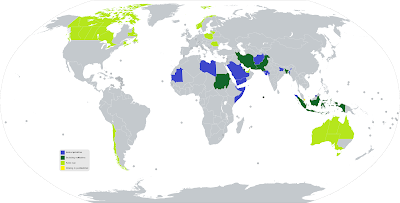Let’s look at this topic here. Basically, what we are dealing at here is an alcohol monopoly of some sort. In one sense, it is used as an alternative to the total prohibition of alcohol consumption — it reduces consumption but not all the way to zero (as in the countries shown in this map, from Wikipedia).
There have been a number of formal studies published in the health literature, looking at a range of countries with different alcohol policies, in order to evaluate the effects of government control of alcohol sales.
For example: Comparative analysis of alcohol control policies in 30 countries.
Donald A Brand, Michaela Saisana, Lisa A Rynn, Fulvia Pennoni, and Albert B Lowenfels. PLoS Medicine 2007 Apr; 4(4): e151. They note:
To assist public health leaders and policymakers, the authors developed a composite indicator — the Alcohol Policy Index — to gauge the strength of a country's alcohol control policies. The Index was applied to the 30 countries that compose the Organization for Economic Cooperation and Development, and regression analysis was used to examine the relationship between policy score and per capita alcohol consumption. The strength of alcohol control policies, as estimated by the Alcohol Policy Index, varied widely among 30 countries located in Europe, Asia, North America, and Australia. The study revealed a clear inverse relationship between policy strength and alcohol consumption.Similarly, a more ambitious study compared several different Indexes and many more countries: Alcohol control policies and alcohol consumption: an international comparison of 167 countries. Joana Madureira-Lima, Sandro Galea. Journal of Epidemiology and Community Health 2018; 72: 54–60. Their conclusion is:
Index scores and ranks from different methodological approaches are highly correlated (r=0.99). Higher scores were associated with lower consumption across the five methods. For each 1 score increase in the ACPI, the reduction in per capita alcohol consumption varies from −0.024µL (95%µCI (−0.043 to −0.004) to −0.014µL (95%µCI (−0.034 to 0.005).So, government control of alcohol availability really does seem to achieve its goal of reducing consumption, without actually eliminating it. The World Health Organization does, of course, have an approving report on this topic: Government monopoly on retail sales.
According to Wikipedia:
[Alcohol monopolies] exist in all Nordic countries except Denmark proper (only on the Faroe Islands), and in all provinces and territories in Canada except Alberta (which privatized its monopoly in 1993). In the United States, there are some alcoholic beverage control states, where alcohol wholesale is controlled by a state government operation and retail sales are offered by either state or private retailers.The graph immediately above is from the paper by Madureira-Lima and Galea, listing the Alcohol Control Policy Index (ACPI) for a range of countries. In this case, the bigger the score then the tighter is the government control.
Note that the USA is a long way down the list, although it is not that far behind the United Kingdom, for example. So, there is some sort of serious government control. Wikipedia lists the 17 control or monopoly U.S. states in November 2019 as:
Alabama
Idaho
Iowa
Maine
Michigan
Mississippi
Montana
New Hampshire
North Carolina
Ohio
Oregon
Pennsylvania
Utah
Vermont
Virginia
West Virginia
Wyoming
Apparently, about one-quarter of the United States’ population lives in these control states.
The figure above also confirms that the Nordic countries have the greatest government control (ie. Denmark, Finland, Iceland, Norway and Sweden are at the top of the list). The World Health Organization has approvingly discussed their situation: Reducing alcohol consumption, the Nordic way: alcohol monopolies, marketing bans and higher taxation.
For those of you who are interested, I have written several relevant posts about the Nordic situation, notably with regard to Sweden (where I live), and often disagreeing with the view of outside commentators:
- Wine monopolies, and the availability of wine
- Which countries are dominated by only a few alcohol suppliers?
- Why is wine often cheaper in Sweden than elsewhere?
- Is Scandinavia currently the most attractive wine export market?
I will finish with a recent pertinent web exchange, about the USA:
Tom Wark
My biggest fear is the rise of institutional Neo-prohibitionism. In my view, the threat of government action against alcohol is greater now than it has ever been.Jeff Siegel:
The solution will require everyone in the wine business — producers, wholesalers, retailers, importers, and the rest — to work together. Which is almost impossible, and may be wine’s biggest problem.



Great article, David. It's refreshing to engage with your insightful perspectives on alcohol risk mitigation. With the heightened focus on alcohol-related discussions anticipated in 2024, it's imperative that more individuals adopt a constructive approach to to the topics of reform, much like you have.
ReplyDeleteIt's important for those in the wine writing sector, especially the veterans among you, to be mindful of the language used when discussing policy and individuals. Made up spin terms like 'Neo-prohibitionist' purposely carry a mocking tone, while labels such as 'anti-alcohol' are overly simplistic and reflect bad faith arguments.
The wine industry is currently navigating a crucial juncture where its traditional association with hospitality and community is being questioned. The industry's challenge is to move beyond the stereotypes of exclusivity and elitism, and to rediscover the essence of inclusivity that once defined it. Wine, in its truest sense, should symbolize a culture of appreciation, rather than being seen as a symbol of privilege, entitlement and the mocking of out groups.